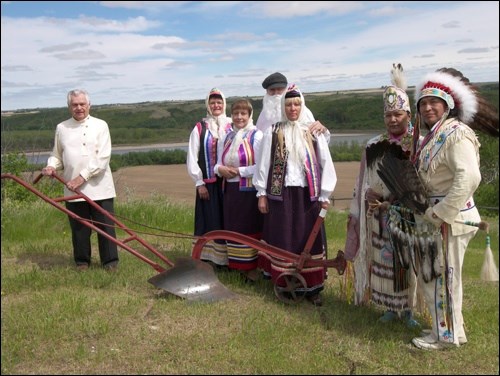In the late 1890s, displaced Doukhobors came to Canada and settled in a number of areas, including a site on the banks of the North Saskatchewan River southeast of present-day Blaine Lake.
They came late in the year and fashioned dug-out houses in the banks of a ravine for shelter until they could build houses for themselves.
At the earliest possible opportunity, the Doukhobor men headed east to earn some money working on the railroad which was slowly making its way across Saskatchewan. They took the horses and oxen with them because workers with horses or oxen got higher wages. That left the women to do what they could to till the land and plant gardens and crops for their food.
The Doukhobors had a long history of resourcefulness and finding ways to eke out a living from the land, so this circumstance was nothing new. Instead of trying to break the tough prairie sod by hand, the women made a plough out of wood and then fashioned an apparatus that allowed up to eight pairs of women to pull it. In this way, they were able to break the sod, turn the soil, and plant the crops.
As the women pulled, they sang, and understandably, this all attracted some attention from the First Nations people who lived on the Muskeg Reserve nearby. One of the men from the Greyeyes family felt compassion for the women and brought a horse for them to hitch to the plough. He did this under the cover of night because the horses had come to the reserve from the Government of Canada and were not supposed to be taken off the reserve.
In return for their kindness, the Doukhobors shared their crops and vegetables with their First Nations neighbours.
"Both sides were thankful for the mutual cooperation," says Brenda Popov-Cheveldayoff, director of the Doukhobor Dugout House site which is now a provincial and national heritage site.
Every year, a special open house is held to celebrate the historical significance of the site and share some of the Doukhobors' unique history. This year's event will be on Saturday, July 3, and feature a reenactment of the Doukhobor women pulling the plow and the First Nations people bringing them a horse to do the work.
The program begins at 11 a.m. sharp with the reenactment.
"Twelve women in Doukhobor costume will be pulling a plough, singing a traditional Doukhobor working song," says Bill Kalmakoff, a long-time member of the community. "The words of the songs they sang would have been about everyone working together to plant and give glory to God."
As the women are ploughing, a First Nations couple in full regalia (played by Fred Campiou and his wife Melanie Dreaver) will enter the yard in a wagon to present a horse. They will perform a traditional ceremony which includes singing and dancing and erecting a tipi. In return, the Doukhobors will respond with a heart-felt welcome and present the First Nations people with a Doukhobor gift, reliving the strong friendships that were established between the two cultures in the late 1890s.
Popov-Cheveldayoff says the program will include greetings from various dignitaries and an address from Norm Rebin, MC for the day.
"Because the theme of the day is food and survival," Popov-Cheveldayoff adds, "we're tying it in with the Saskatoon Food Bank. We're asking people who come to bring a non-perishable item for the Food Bank. The director, Paul Merriman, has been invited to receive the donations." Proceeds from admission will also be donated to the Food Bank.
Following the reenactment, visitors can tour the site, enjoy traditional Doukhobor pastries, and browse through the museum which displays artifacts from the early days of the Doukhobors in Saskatchewan, as well as findings from the archaeological dig that was done on the site.
"Interestingly, the skeleton of a horse was unearthed in the dig," says Popov-Cheveldayoff. "It was dated at 105 years old. Quite possibly it was the gift horse from the First Nations people."
Visitors can also go on a tour of the dugout house site led by Jeannette Stringer.
The Doukhobor Dugout House Site will be open all day on July 3, and every Saturday thereafter until August 7. Guided tours are available.
To reach the Doukhobor Dugout House site, take Highway No. 41 north toward Blaine Lake and follow the signs.




